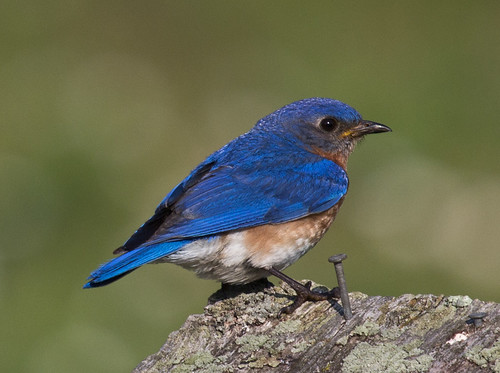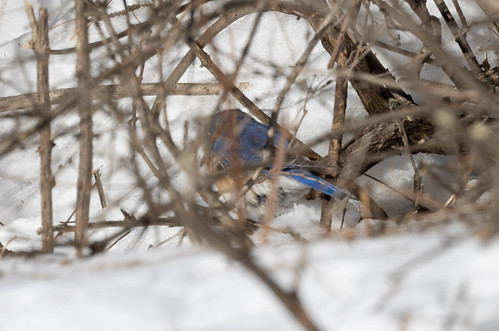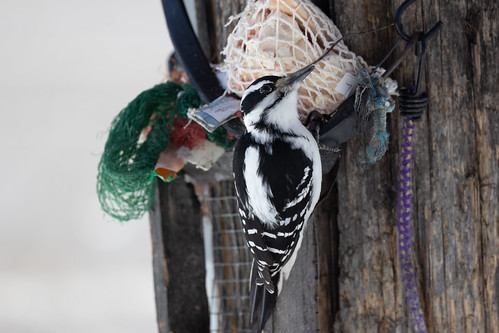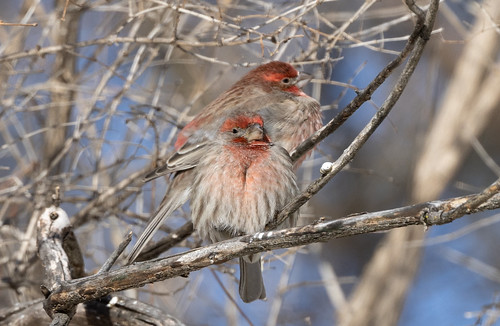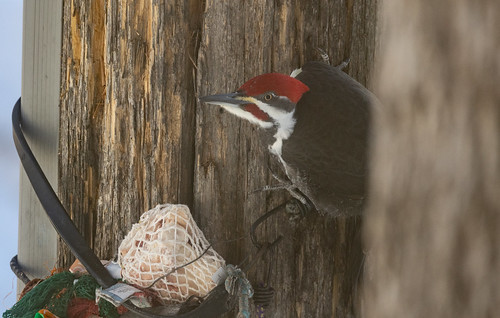On February 2, when the Northland’s woodchucks, aka groundhogs, were safely hibernating except the pitiful few being forced against their will to pretend to be meteorologists, I drove over to a house in the Kenwood neighborhood of Duluth, hoping to see an overwintering Eastern Bluebird. Bluebirds don’t hibernate, but every fall they are supposed to light out for their wintering range way south of here. Seeing one on a frigid February day is as improbable as seeing a wild groundhog, so I could hardly resist when Vi Adams sent me an email this week telling me about her visitor, who’s been hanging out in her yard since October.
Not only are bluebirds not supposed to be here at all right now—they’re also not supposed to visit feeders at all, though some people who run bluebird trails have enticed them to specially designed bluebird feeders by offering live mealworms and homemade concoctions of such ingredients as suet dough; dried mealworms; and dried, frozen, or fresh fruits. Vi keeps her normal bird feeders filled with a simple commercial fruit and nut mixture that kept her feeders hopping the whole time I was there and is apparently tasty enough to draw in the adult male bluebird a few times each day as well. When not at her front yard feeding station, she often sees him hanging out in and below a dense shrub in her backyard. Some large pine and spruce trees back there almost certainly provide protected roosting spots, but he’d be hard to pick out in them.
Birds have wings and know how to use them, so it’s always a crapshoot whether we’re going to see even the most reliable bird when we chase a rarity. I was at Vi’s house from about 1:45 pm until 4, but the little guy didn’t come to the feeders once while I was there. I did get a decent but very quick look at him hunkered down and feeding on the ground beneath that dense shrub. The two photos I took are exceptionally poor, though the bluebird is at least identifiable in them.
When the sub-zero temperature got too much for me standing out there, Vi invited me in for a cup of cocoa while we maintained our vigil at the window overlooking the feeders.
As cool as seeing a bluebird in February might be, it was equally cool getting to know Vi as I watched her regular feeder visitors. I’d already taken closeups of a Hairy Woodpecker on her suet...
...and some House Finches in back being more cooperative than the bluebird in the same shrub.
From in the house I got decent shots of a Red-bellied Woodpecker...
...and a Pileated.
Back when Russ and I moved to Duluth in 1981, Red-bellied Woodpeckers any time of year were as rare as bluebirds in winter are now, but this non-migratory species has become an everyday bird in just about every neighborhood. Pileated Woodpeckers haven’t expanded their range—they were always found around Duluth—but in 1981, it was a big event when one visited a backyard in town, and huge when one came to a bird feeder. I often saw and heard Pileated Woodpeckers around my mother-in-law’s property in rural Port Wing, Wisconsin, but they virtually never showed up at her feeders, either. I remember how thrilled I was when one guy I nicknamed Jeepers showed up at my window suet feeder in 2004.
After he moved on, I didn’t see another in my feeders for years. Now, in recent years, they’re showing up at suet feeders all over—this winter I've had three individuals coming very often! But this represents a change in behavior, not a change in range.
Is Vi’s bluebird evidence of climate change? Not really—individuals of most species vary at least somewhat in their migratory habits. It’s when some of those individuals wintering further north survive to breed that their genes are replicated in their young. Over long periods of time, individual Red-bellied Woodpeckers and cardinals—both non-migratory species— who wandered north started surviving and breeding north of where our range maps said they were supposed to be, and a few of their young scattered even further north. In the case of Red-bellied Woodpeckers, the hardwood trees they require are slowly replacing the birches and firs dwindling in our changing climate.
Assuming Vi’s bluebird survives and reproduces after this relatively harsh winter, it’s possible some of his young will share his tendency, but as in the case of Red-bellied Woodpeckers, even as climate change continues apace, it’ll take many decades before individual wintering bluebirds have multiplied to the extent that we can take them for granted. That is something my baby grandson may see in his lifetime. I'll never see that, but I’m sure glad I got a glimpse, even a momentary, crappy one, of Vi’s exceptional little bird.
